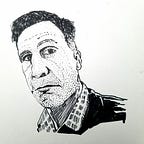Legos Capture the True Spirit of Hemingway
Hemingway’s spare story, “The Killers,” just under 3,000 words and characteristically laconic, has seen several film adaptations since it was first published in 1927. The latest by Silleck Family Productions most loyally and most inventively captures the original.
Hemingway’s “The Killers” is the story of two assassins, Max and Al, who come into a diner to kill “The Swede,” also known as Ole Andreson, a retired boxer who dines at the establishment regularly at 6 pm. The assassins order dinner from the proprietor, George, and then proceed to tie up the one other customer, Nick Adams, and the cook in the kitchen while George sends any new customers away as instructed, claiming that the cook is out. The Swede never shows, and the assassins decide to let George, Nick, and the cook go without killing them. George talks Nick into going to the Swede’s rooming house to warn him of the killers. Nick acquiesces and finds the subdued Swede lying in bed with his clothes on and explains what has happened, but the Swede is resigned to accept his fate, says that going to the police will do no good, and that he won’t try to escape because he’s “through with all that running around.” Nick returns to George and tells him how the Swede reacted and how he can’t stand thinking of him simply waiting for his executioners to do him in. George advises him not to think about it.
Robert Siodmak’s The Killers from 1946 uses the Hemingway text as a springboard for a full-length Hollywood film featuring Eva Gardner and Burt Lancaster and greatly expands on the story. Another version was directed by Don Siegel and intended for television, though it was released in theaters in 1964 after being deemed too violent for TV. The Siegel adaptation includes little to no dialogue from the original story, and the boxer is turned into a race car driver played by John Cassavetes. Apparently the great Andrei Tarkovsky, director of a number of esteemed films including the Russian adaptation of the Polish novel, Solaris, by Stanisław Lem, made a twenty-one minute version of “The Killers” with a couple of schoolmates at the State Institute of Cinematography in Moscow in 1956. All three of these versions are available in a set put together by The Criterion Collection.
“Ernest Hemingway’s The Killers” as reinvented by Silleck Family Productions is a twelve-minute stop-motion animated film with Lego minifigures and a set made entirely with Lego pieces. Sean Silleck’s script remains very close to the original text. Unlike the Hollywood versions that expanded on the story, Silleck’s is almost entirely comprised of the original dialogue pared down even further due to the elimination of the character of the cook and Mrs. Bell, the attendant at the rooming house where the Swede is living. One of the two assassins, Max, is changed to a female character so that Devon Cummings (Sean’s wife) can play the role, and she does so with an impeccably film noir saucy style. While all the characters are portrayed memorably, Max’s voice stands out and I’m certain that I’ll never again read the Hemingway original without hearing Devon Cumming’s dry, tough voice in my ear.
Silleck Family Productions describes itself as “a small film company specializing in stop motion Lego films based on vintage, hardboiled short stories by American literary masters.” The description is apt as their film studio is the basement of their home in Hastings-on-Hudson, New York, and the husband-wife-son team handle all elements of the film. Sean and his son Owen direct, and Owen is credited with the soundtrack, with songs attributed to Miles Davis among others and sound effects as evocative as a radio play. The voice of Al is the young talent Owen Silleck, while Sean Silleck convincingly plays the unassuming lunch counter proprietor, George, and the everyman diner customer, Nick. In a spirited twist and nod to the 1946 film version, the voice of the Swede is taken from Burt Lancaster’s portrayal in Siodmak’s 1946 film. All the characters come vividly to life with pitch-perfect voiceovers, pauses, and gestures, enhanced by moody black-and-white shots and sharp angles, shadowy lighting, and clever sound.
What strikes me the most is the effect of the Lego stop-motion technique combined with the film noir style. The macho posturing of hard-boiled novels and movies is rendered ridiculous by the contrast of the child-toy actors, and yet despite the parody, we nonetheless get caught up in the suspense of the situation. The pretense is always in the foreground as we see the Lego grid street and logos, and yet, even as we laugh with delight at Lego actors spouting tough-guy dialogue, the power of Hemingway’s bleak stoicism comes through effectively. Perhaps the lack of human actors carries the theme even further. If Hemingway suggested a dignity in facing our inevitable mortality rather than denying it, the robotic actors in the Silleck production hint at a world in which humanity is no longer — or at least deemphasized and cyborg. As we encounter the brink of climate disaster and the advent of artificial intelligence and ubiquitous robotic capabilities — and as the power of the individual to effect change in this intractable inexorable future wanes, do we act like the Swede and turn to the wall with resigned fatalism?
At any rate, the twelve-minute film is a creative triumph and a joy to watch. This premiere production promises great things to come from Silleck Family Productions, and I can’t wait to see the results of their next efforts: Nelson Algren’s “The Face on the Barroom Floor,” Flannery O’Connor’s “A Good Man Is Hard to Find,” and Raymond Chandler’s “Pick Up on Noon Street.”
Watch “The Killers” and stay up on the latest ventures of Silleck Family Productions at https://vimeo.com/silleckfamilyproductions/.
